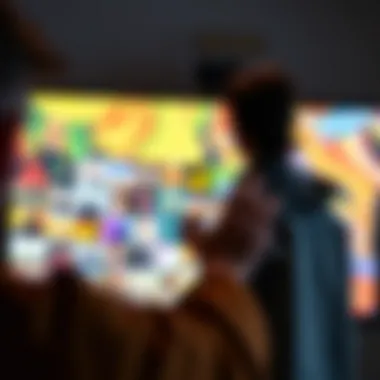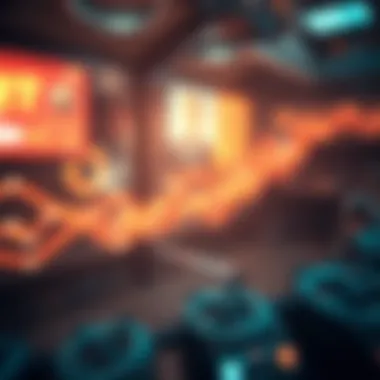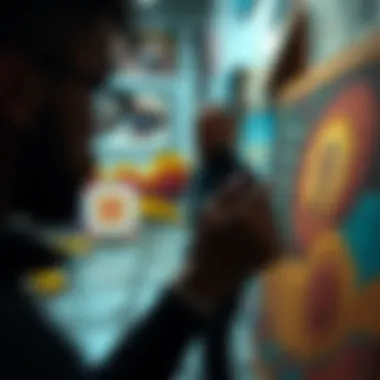Monetizing Creativity: Selling Photos as NFTs


Intro
In the fast-paced world of digital innovation, the creative landscape is undergoing a seismic shift. Photographers, who once relied solely on traditional galleries and exhibitions to showcase their work, are now stepping into a world where digital ownership thrives. This shift not only democratizes art but also offers numerous earning avenues. Enter NFTs—or non-fungible tokens—representing a revolution in how we perceive ownership and authenticity in the digital space.
The essence of NFTs lies in their uniqueness; unlike cryptocurrencies like Bitcoin or Ethereum, which are interchangeable, each NFT carries its own distinct value and attributes. Imagine selling your photography as an NFT. This means your work could potentially garner higher prices due to its rarity and the blockchain technology backing it. But, as with all ventures, navigating this terrain isn't without its hurdles. This article aims to unravel the complexities behind transforming your photos into NFTs, exploring the markets, challenges, and the strategies that can turn your passion into profit.
Market Analysis
Current Trends in Cryptocurrency
As we dive into the NFT sphere, it's crucial to gain insights into the broader cryptocurrency landscape. Over the past few years, cryptocurrencies have surged in popularity, gathering traction among both individual investors and major corporations. The integration of blockchain technology into various aspects of art has catalyzed a rapidly evolving market for NFTs. From digital art exhibitions to virtual galleries, the explosion of interest in NFTs is hard to ignore.
However, with this boom comes volatility. Prices can swing wildly, influenced by everything from celebrity endorsements to market speculation. Photographers entering this space must stay informed about market trends, as their work's value could change drastically overnight.
This trend impacts not only how we buy and sell but also how we perceive art. Rather than resting on physical canvases, art can now inhabit digital realms, reaching audiences worldwide instantly.
Price Prediction Techniques
When it comes to the economics of NFTs, understanding price prediction can feel like reading tea leaves. Here are some techniques that might help you gauge potential market movements:
- Trend Analysis: Keep an eye on historical price movements. Analyzing previous sales can provide insights into what makes certain pieces valuable.
- Community Engagement: Engaging with online communities on platforms like Reddit or Discord can provide grassroots insight into the demand for specific styles or themes in photography.
- Market Sentiment: Observing major shifts in investor interest, driven by social media trends or news cycles, can be indicative of where the market is heading.
Equipped with these insights, a photographer can strategically price their NFTs, ensuring they remain attractive to potential buyers while still reflecting the value of their artistry.
"In the realm of art, the lines are blurred between creator, collector, and consumer, reshaping the traditional ideas of ownership and value."
Investment Strategies
Long-Term vs Short-Term Investing
Navigating the NFT space means confronting a pivotal question: Are you in it for the long haul, or are you looking to make a quick buck? Long-term investors may focus on building a portfolio of photography NFTs they believe will appreciate over time. This strategy often requires patience but can lead to significant rewards as the market matures.
On the flip side, short-term investing may yield rapid returns, capitalizing on fluctuating market trends. However, this approach demands a keen eye for emerging trends and the ability to act swiftly when opportunities arise. The gamble is high but can lead to substantial gains—or losses.
Risk Management in Crypto Trading
As with any investing landscape, risk management is key, especially in such a volatile domain as NFTs. Here are some strategies to consider:
- Portfolio Diversification: Don’t put all your eggs in one basket. Instead of concentrating on one type of photo or theme, spread your investments across various styles.
- Stay Informed: Continuously educate yourself. The crypto world changes at lightning speed, so staying updated with news and trends can make all the difference.
- Set Financial Limits: Decide in advance how much you are willing to invest—and potentially lose. This approach can prevent emotional decision-making during market dips.
By implementing these strategies, photographers can better navigate the complexities of selling their work as NFTs, ultimately striving to maximize their creativity's potential.
Understanding NFTs
In the rapidly evolving landscape of digital content, understanding Non-Fungible Tokens (NFTs) is crucial for those looking to explore opportunities in monetizing creativity, particularly for photographers. As this novel medium expands, grasping the intricacies of NFTs becomes more than just an academic exercise—it’s a pathway to bankable artwork.
NFTs have fundamentally changed the way art is perceived and sold. For photographers, this can translate into not only a new revenue stream but also a means to establish a digital presence and connect with audiences in a way that was not previously available. Understanding NFTs allows photographers to leverage their artistry in versatile settings, diversifying income and possibly stepping into a realm where traditional art markets may have fallen short.
Definition of NFTs
To break it down simply, NFTs are unique digital assets that represent ownership or proof of authenticity of a specific item—often digital art or collectibles—on the blockchain. Each NFT is distinct from others, thus the name “non-fungible.” This uniqueness is what gives NFTs their value.
An NFT can be likened to a one-of-a-kind piece of art. Whereas a traditional painting can be copied without altering its essence, an NFT cannot be duplicated in the same sense. Every transaction and detail regarding ownership is transparently recorded in the blockchain, ensuring that buyers can ascertain the provenance of their purchase.
How NFTs Work
The functioning of NFTs hinges on blockchain technology, most commonly connected with Ethereum. When an artist, say a photographer, decides to mint a photo as an NFT, the image is uploaded to an NFT marketplace (like OpenSea or Rarible). Here's how it usually unfolds:
- Creation: The photographer uploads the image and includes descriptions, such as title, edition (if applicable), and additional context about the piece.
- Minting: This is the process of converting the digital file into an NFT. Once minted, it becomes a part of the blockchain, where details about the piece are permanently recorded.
- Listing for Sale: After minting, the creator sets a price and can either list it for sale or hold an auction.
- Transaction: When a buyer decides to purchase, the transaction is executed. Funds are exchanged, and the blockchain adjusts being to reflect new ownership.
Transacting through NFTs eliminates some traditional barriers faced in the art community, giving power back to creators.
The Blockchain Connection
At the heart of NFTs lies blockchain technology, a system that provides transparency and security—two critical factors for buyers and sellers alike. Think of the blockchain as a public ledger, which is maintained across a network of computers. This immutable record allows anyone to verify the authenticity and ownership of an NFT without relying on intermediaries.
Why does this matter to photographers? Well, having your work recorded on the blockchain means:
- Proof of Ownership: Artists retain proof that their work is theirs, which is especially significant in an industry rife with copyright issues.
- Royalty Mechanisms: Through smart contracts, photographers can set conditions that enable them to receive royalties every time the NFT is resold. This means creators could earn ongoing revenue, unlike traditional sales models.
- Global Reach: Photographers can connect with a worldwide audience instantly, transcending geographical limitations.
In summary, NFTs represent a revolutionary shift in how art can be owned, traded, and experienced. Understanding these fundamentals is essential for any photographer eager to dive into the digital token space and capitalize on their creative output.


The Rise of Digital Art
The digital art landscape has seen an unprecedented surge in popularity and accessibility in recent years. This newfound prominence of digital creativity holds significant relevance for photographers considering the lucrative world of non-fungible tokens (NFTs). Embracing this trend provides a golden opportunity for artists to gain exposure and perhaps, wealth, by tapping into the evolving market where traditional art is no longer the only dominator.
Trends in the Digital Art Market
Several key trends highlight the changing dynamics within the digital art market:
- Increased Accessibility: With more platforms emerging, artists from all backgrounds can easily share and sell their work. No longer is artistic talent confined to galleries or exclusive exhibitions.
- Community-Focused Culture: Digital art thrives on collaboration, with online communities rallying behind favorite creators. Support can come from fans, collectors, or fellow artists, enriching the creative process.
- Diverse Revenue Streams: Artists now have numerous ways to monetize their work. From selling prints to offering exclusive content through memberships, opportunities abound.
- Influence of Tech Giants: Major tech companies are investing in digital art spaces, encouraging a consolidation of resources that enhances exposure for artists.
As the market grows, it’s crystal clear that connecting with emerging trends can be a game changer for photographers venturing into NFTs.
NFTs Revolutionizing Art Ownership
The advent of NFTs has given artists a powerful tool to rethink ownership and value in the art world. By utilizing blockchain technology, NFTs allow creators to establish verifiable ownership of their work, a crucial factor in combating art theft and piracy. Here are a few important considerations:
- Traceability of Ownership: Each NFT is linked to a unique identifier on the blockchain, ensuring that an owner can authenticate the original piece.
- Royalties for Creators: Many NFT platforms provide creators with built-in royalty mechanisms, allowing artists to earn money from secondary sales of their works.
- Shifting Perspectives on Value: NFTs encourage buyers to appreciate digital artwork in a way that transcends traditional forms. The notion of owning a unique digital asset is reshaping consumer attitudes toward art purchases.
Can Photographers Sell NFTs?
In the ever-evolving landscape of digital art, the intersection of photography and blockchain technology has created a unique opportunity for photographers to monetize their work through NFTs. As the market matures, understanding whether photographers can participate in this space becomes crucial. The potential for profit, the ability to reach global audiences, and the transformation of artistic ownership all hinge upon the nuances of selling photographs as NFTs. This section explores essential elements that define this possibility, benefits of engaging in it, and considerations that photographers must keep in mind.
Eligibility Criteria
To venture into NFT sales, photographers must first comprehend their eligibility. Not all images make the cut, and a few key criteria must be checked:
- Original Work: Photographers must own the rights to their images. The clear-cut rule is that intellectual property rights need to be held by the creator to sell their art as an NFT.
- Unique Presentation: While the internet allows for endless reproduction, the uniqueness factor plays a pivotal role in NFT sales. Simply posting a photo online does not mean it can be sold as an NFT. Many platforms require a distinctive form, often with some creative twist.
- Adherence to Platform Policies: Different NFT marketplaces have their own rules. It's important for photographers to read the fine print. Some might restrict certain types of content, while others focus exclusively on specific niches within digital art.
By keeping these criteria in mind, photographers can sidestep potential pitfalls while successfully tapping into this trend.
Rights and Ownership Issues
The conversation surrounding rights and ownership cannot be ignored, especially in the realm of NFTs. Unlike traditional art, where ownership transitions through sale or auction, NFTs present a new layer of complexity. Here's what to consider:
- Copyright Ownership: Photographers must have a solid grasp of copyright laws. In essence, selling an image as an NFT does not automatically transfer copyright ownership unless explicitly stated. Buyers often assume they gain some rights, which might not be the case.
- Smart Contracts: The technical backbone of NFTs, smart contracts outline the terms of the sale and ownership. Thus, photographers need to craft clear agreements that delineate how their work can be used post-sale—this includes reproduction rights or derivations.
- Moral Rights: Photographers may retain certain moral rights even after selling their work as an NFT. This could mean, for example, the right to be identified as the creator of the work or the right to object to derogatory treatment of it.
Understanding these aspects can help photographers navigate the murky waters of rights and ownership, ensuring clarity for both themselves and potential buyers.
"In the realm of digital assets, knowledge of your rights is akin to knowing the ropes in a stormy sea. It’s about empowerment and protection."
Creating Your NFTs
Navigating the world of NFTs can feel a bit like venturing into uncharted waters, especially for photographers who are just dipping their toes into the cryptocurrency pond. Creating your NFTs is more than just a technical process; it involves careful thought about how to represent your artistic vision in a new, digital format. The significance of this topic cannot be overstated, as the way you approach this can determine the success of your work in the NFT landscape. It’s where creativity meets technology, and finding the right balance can amplify your artistic expression while also making it profitable.
Choosing the Right Platform
The first hurdle you’ll come across is selecting the right platform for minting your NFTs. There are numerous marketplaces out there, each offering different features and targeting various audiences. While popular platforms like OpenSea and Rarible provide extensive reach, you may find niche platforms more aligned with your artistic style or specific photography genre. For instance, if your focus is on fine art or wildlife photography, platforms like Foundation or KnownOrigin may serve you better, allowing your work to shine amongst like-minded artists.
Some points to consider when picking a platform include:
- User Experience: A straightforward interface can be a breath of fresh air, especially if you're just getting started. Platforms that provide tutorials or guides can ease the learning curve.
- Fee Structure: Pay attention to their commission rates. Some platforms charge higher fees, which can eat into your profits. Analyze this closely before deciding.
- Community Engagement: A platform with a vibrant community can offer networking opportunities and exposure to potential buyers.
Minting Your Photographs
Once you've settled on the platform, you’re ready to mint your photographs into NFTs. This process is akin to publishing a book; it transforms your artistic work into a token that lives on the blockchain. Minting involves uploading your image and adding certain metadata like title, description, and attributes that help your NFT stand out. The quality of the photograph matters, so ensure you’re using high-resolution images to do justice to your work.
Here’s a brief rundown of what minting might look like:
- Upload: Select a high-quality image.
- Details: Input a descriptive title that captures the essence of the work.
- Royalties: Set up royalties upfront to reap additional benefits every time your work is resold. This ensures ongoing income from your creations.
- Confirm: Once satisfied, you’ll finalize the minting process, which may require a transaction fee depending on the network congestion.
Setting a Price
Setting a price for your NFT is a balancing act. You might feel like pricing too low could undervalue your work, but pricing too high might turn potential buyers off. Research similar photography NFTs and observe how they are priced. Analyzing sales data can provide insights into the market trends.
Consider these factors when determining your price:
- Rarity: If your photograph is part of a limited series, you may be able to charge a premium.
- Market Demand: Gauge the interest in your subject matter. The more sought after your genre, the better your pricing can be.
- Your Reputation: If you’ve built a brand as a skilled photographer, leverage that when pricing your NFTs.
Ultimately, finding the sweet spot for your NFT pricing takes time, observation, and a bit of intuition. Don’t be afraid to experiment with different pricing strategies.
Remember, the world of NFTs is fast-moving and constantly evolving. Key is to stay flexible and keep learning as you go.


Marketing Your NFT Photographs
Marketing is the lifeblood of selling NFTs. It sets the stage where your works can shine, find audiences and, ultimately, convert into profits. When photographers transition their art into NFTs, they step into a digital marketplace that is both exhilarating and daunting. While the technology offers a pathway to new audience engagement, the demand for effective marketing strategies cannot be understated.
Creating eye-catching NFT photographs is just half the battle. The real kicker is how well you can make those works known and desirable in an ocean of digital art. Here’s where a robust marketing plan comes into play that can ultimately make or break your venture.
Building an Online Presence
An online presence is vital for photographers looking to sell their NFTs. Maintaining a portfolio or a gallery-like website can act as a cornerstone of your digital identity. Think of it as setting up your studio in a high-traffic zone instead of a back alley—visibility does matter. It is essential not only to showcase your NFTs but to highlight your unique style and artistic evolution.
Your website should:
- Include an engaging bio that tells your story.
- Display your work prominently, making it easy for potential buyers to navigate through.
- Incorporate a clear call-to-action, guiding visitors on how to purchase your NFTs or get in touch with you.
Furthermore, consistent engagement across various platforms can enhance your visibility. Regular updates and fresh content are like oxygen for your online presence. Blogs about your artistic process or thoughts on current trends can attract attention while strengthening your credibility.
Leveraging Social Media
Social media platforms are non-negotiable tools in your marketing arsenal. They allow you to engage directly with potential buyers. For NFT photographers, Instagram, Twitter, and even TikTok provide avenues for reaching wide and diverse audiences. Creating eye-catching posts that showcase snippets of your work can create buzz.
When sharing, consider the following:
- Use Hashtags Wisely: While it can be tempting to slap on every trending tag, focusing on niche hashtags related to NFTs and photography can attract the right crowd.
- Storytelling: Share your creative journey through posts, reels, or stories. People are often attracted to the ‘why’ behind the photo, which can add emotional depth and a connection to your work.
- Engagement is Key: Don’t just post and ghost. Respond to comments, participate in conversations, and perhaps even host live Q&A sessions to foster community and interest around your work.
Engaging with the NFT Community
Engaging with the NFT community is critical. It can be like finding a family that resonates with your artistic visions. Online forums, Discord servers, and platforms like Reddit are vibrant hubs for NFT enthusiasts. By being active in these communities, you open doors to networking and collaboration opportunities.
A few ways to engage include:
- Joining Groups: Look for Discord channels or subreddits focused on NFT art. These spaces frequently share valuable advice on marketing and technicalities of NFT selling.
- Participate in Events: Attend NFT exhibitions or webinars. These gatherings are rich with networking opportunities, and your presence alone can pique interest in your work.
- Collaboration is Golden: Find fellow artists or photographers to collaborate with on special projects or themed drops. Together, you can leverage each other’s audiences for mutual gain.
Remember: Building a network takes time but can yield substantial rewards in terms of visibility and sales. Successful NFT artists often stress that community collaboration is key in a world characterized by competition.
In summary, effectively marketing your NFT photographs requires a blend of strategic planning, a solid online presence, astute social media engagement, and active community involvement. Balancing these factors can help your artwork stand out in a crowded marketplace, providing both monetary benefits and personal satisfaction.
Evaluating the Financial Aspects
Understanding the financial elements of selling your photographs as NFTs is crucial for anyone looking to navigate this burgeoning market. Photographers must grasp not just the potential for profit but also the underlying costs involved.
Understanding Fees and Commissions
When entering the NFT space, keep in mind that various fees can potentially chip away at your earnings. It’s like the old saying: "A penny saved is a penny earned." This holds true in the digital art market where several platforms impose different fees.
- Minting Fees: Each platform has its own minting fees for converting your photographs into NFTs. These fees range from pennies to several dollars, depending on the network traffic and platform used. For instance, OpenSea charges a gas fee typical for Ethereum-based tokens. On the other hand, some newer platforms may have lower or even zero minting fees.
- Transaction Fees: Many platforms take a commission on sales, generally around 2.5% to 15%. If someone pays a hefty price for your piece, that commission can take a big slice of your profit.
- Marketplace Fees: Be aware of the market you're selling on. Each has its own unique commission structure that can vary widely. For example, Rarible and Foundation operate differently than larger platforms; their fees might be different and can affect your net earnings.
A critical aspect here is to .factor these fees into your pricing strategies. Knowing what you stand to lose can be just as important as knowing what you might gain.
Potential Earnings from Sales
It's understandable to wonder just how much you can earn through NFT photography. Some creators have made millions, while others are still trying to get their feet wet. It’s a bit like playing the stock market; some days you strike gold, others you’re left high and dry. Here are several considerations when pondering potential earnings:
- Price Setting: Your initial price point plays a significant role. If you undervalue your work, you might attract buyers but miss out on opportunities for substantial revenue. Conversely, pricing too high can scare off potential collectors.
- Market Demand: The NFT art world is heavily influenced by trends, just like any other art market. New styles, themes, or even the popularity of particular artists can drive demand. Keep an eye on trends and adjust accordingly.
- Rarity and Exclusivity: The fewer NFTs of a certain piece you create, the more exclusivity it holds, which can elevate its value. Consider offering limited editions, where scarcity can drive demand.
- Royalties: One attractive aspect of NFTs is the royalties that every subsequent sale can generate. If someone resells your NFT, you might earn a percentage of that sale. This ongoing revenue stream can significantly boost overall earnings over time.
In the end, evaluating potential earnings is about more than just numbers. It’s about understanding your audience, market conditions, and how to market your unique artistry effectively.
"Art is not freedom from discipline, but disciplined freedom."
— John F. Kennedy.
By understanding the nuances of fees and the pathways to ideal earnings, photographers can better position themselves in the NFT market. As you consider your next steps, keep these financial aspects at the forefront of your strategy.
Challenges in the NFT Market
Navigating the world of NFTs can feel like sailing through uncharted waters. While there's vast potential for profit, there are also pitfalls. As photographers delve into this new marketplace, understanding the challenges is more critical than ever. This section will shed light on two primary hurdles that stand in the way of similar ventures: market volatility and environmental concerns. Addressing these challenges can help artists and investors make informed decisions, and ultimately, secure their place in the digital art realm.
Market Volatility
Let’s face it, the NFT market is a wild ride. The hype can swing like a pendulum, leading to prices rising one moment only to crash the next. For photographers eager to sell their work, this can be daunting. The value of an NFT isn’t fixed; it can be influenced by numerous factors such as trends, buyer demand, and overall market sentiment.
To put it simply, if you decide to jump on the bandwagon, you need to be prepared for the ups and downs. Perhaps a photograph that seemed to have immense value today may not hold its ground tomorrow. Investors often cite this unpredictability as a major concern, making it crucial for photographers to approach their sales strategy cautiously.
Here are a few points to consider regarding market volatility:


- Temporary Fads: NFTs tied to trends can lose value when the buzz dies down.
- Lack of Historical Data: Without long-term trends to reference, predicting price movements can be like trying to find a needle in a haystack.
- Informed Selling: Educate yourself about market sentiment before pricing your work to avoid misjudgments that might lead to losses.
"In the world of NFTs, knowledge isn't just power; it's money in the bank."
Environmental Concerns
When discussing NFTs, one aspect that often gets kicked to the curb is the environmental footprint. The majority of NFTs are minted on blockchains that rely on energy-intensive consensus mechanisms, like Proof of Work. This not only raises eyebrows among critics but also taps into a growing global conversation about sustainability and climate change.
For photographers, this isn’t just a political statement; it can affect how their art is perceived. Many buyers are becoming increasingly selective, prioritizing eco-friendly options. If a photographer’s work is inherently bound to an NFT that harms the environment, it may deter potential buyers who are eco-conscious. To fully grasp the implications, take into account:
- Carbon Footprint: Each transaction can contribute significantly to greenhouse gas emissions.
- Alternative Platforms: Exploring blockchains with low energy consumption can help mitigate this issue. Look into platforms like Tezos or Flow that use Proof of Stake, which is more energy-efficient.
- Public Perception: Running the risk of being seen as contributing to environmental degradation may impact a photographer’s reputation.
In summary, while the NFT landscape presents an exciting opportunity for photographers, awareness of market volatility and environmental concerns is paramount. By staying informed, one can navigate these hurdles effectively while balancing creativity and responsibility.
Legal Considerations
The digital landscape is a wild frontier, where creativity flourishes yet legalities can trip you up faster than you can say "non-fungible tokens." Understanding the legal framework surrounding NFTs is crucial for photographers venturing into this innovative market. If you don’t check your legal compass before diving in, you could find yourself navigating rough waters. From copyright issues to the whirring machinery of smart contracts, getting a handle on these elements will protect your work and creative integrity.
Copyright and Intellectual Property
Copyright is the backbone of protecting any artistic creation, and photographs are no exception. When you mint your photos as NFTs, it's essential to grasp the distinction between owning the physical print and the digital rights associated with it. Copyright grants you, as the creator, exclusive rights to reproduce, distribute, display, and sell your work.
- Ownership of Rights: Ensure you maintain ownership of your copyright when you sell your photo as an NFT. Transferring copyrights can often happen unconsciously if agreements aren't clear.
- Licensing Options: Many photographers choose to license their work rather than transferring full rights. This means buyers can own the NFT, but you still hold the right to produce and sell prints of the same photo.
- Protecting Your Work: Consider registering your copyright in your country, such as with the U.S. Copyright Office. This can establish a public record of your ownership, which can be helpful in potential disputes.
It's also wise to provide clear terms when selling your NFTs to set expectations about how the buyer can use the image. Think of it as drawing a line in the sand—you define what they can and cannot do, outlining restrictions on commercial use or reproduction.
Smart Contracts Explained
The term may sound convoluted, but smart contracts are basically just self-executing contracts with the terms of the agreement directly written into code. They serve as the operational backbone of your NFTs, functioning on the blockchain. Here’s why they matter:
- Automated Transactions: Once certain conditions are met, smart contracts automatically execute the transaction, ensuring that you get paid without needing a middleman.
- Royalty Payments: One of the standout features for artists is the ability to program a royalty fee into your NFT. Every time your NFT changes hands, a predetermined percentage can go back to you, the original creator.
- Immutable Evidence: The distributed nature of blockchain technology means that once a contract is written, it’s practically in stone. This can help in resolving disputes since all transactions are documented and can be verified.
In summary, navigating the legalities of NFT photography isn’t just a box to check off; it’s essential to your success. The policies you set make up the protective walls around your creative castle—without them, you may find your artistry vulnerable in an unpredictable marketplace. As you gear up to mint your photos into NFTs, taking the time to understand and implement legal considerations will set a solid foundation for your digital art endeavors.
"An ounce of prevention is worth a pound of cure."
By keeping these aspects in mind, you'll not only protect your intellectual property but also build a reputation as a professional who takes their craft seriously.
Future Trends in NFT Photography
As the landscape of digital ownership and creative expression continues to evolve, NFT photography is positioned at a unique intersection of art and technology. The future trends in this space are not merely about adopting new tools, but about reshaping how we view and value creative works. For photographers eyeing success in this burgeoning market, understanding these trends is crucial.
Innovations in Blockchain Technology
Blockchain technology underpins the NFT ecosystem, and it's constantly advancing. Innovations in this technology could pave the way for more robust platforms focused specifically on photography. One notable development is the inception of layer 2 solutions like Polygon that aim to reduce transaction fees and increase speed. As these technologies mature, they promise to enable a seamless minting and selling process for photographers.
With functionalities such as fractional ownership, artists might soon allow buyers to own a fraction of a particular piece. This democratizes access, letting more people invest in high-value artwork while helping photographers reach a broader audience.
"The best is yet to come – blockchain innovations are set to create avenues that we haven’t even dreamt of yet."
There are also advancements in smart contracts, which can now incorporate terms that automatically pay royalties to creators on subsequent sales. This is a game changer for photographers aiming for long-term profits. Instead of one-time sales, artists can secure a flow of revenue, coining the phrase "creativity pays dividends."
Predicted Market Developments
Looking ahead, various market developments are anticipated that will shape NFT photography. The increasing popularity and acceptance of NFTs by mainstream institutions, galleries, and auction houses contribute to an environment ripe for growth. Major players in the art world, like Christie's and Sotheby's, have begun to embrace NFT auctions, elevating the medium's legitimacy.
Furthermore, as consumers become more environmentally conscious, platforms that utilize eco-friendly processes may gain prominence. These sites are more attractive to those who shy away from traditional NFT platforms due to concerns over their carbon footprint, hence shaping consumer behavior.
Another noteworthy trend is the blending of physical and digital art. Collectors might soon see options for pairing NFT artwork with physical prints or objects. This hybrid approach could significantly boost the appeal of NFT photography, allowing artists to cater to both digital and traditional collectors.
Learn more about the evolving world of NFTs from sources like Wikipedia, or follow discussions on platforms like Reddit to stay updated.
End and Next Steps
As we draw the curtain on this comprehensive exploration of selling your photographs as non-fungible tokens (NFTs), it’s crucial to reflect on both the journey taken and the steps that lie ahead. The world of NFTs is not merely a fleeting trend; it represents a seismic shift in how creativity and tangible ownership are perceived in the digital space. For photographers, this transition opens a vault of opportunities but also presents certain challenges that require careful navigation.
The importance of evaluating your journey as you delve into the NFT market cannot be overstated. It is not just about the sales made or the financial gains achieved, but also about the progress in artistic expression and community building. Reflecting on how your work resonates in this evolving landscape is vital. What feedback did you receive from your audience? How have your strategies morphed based upon experiences? A critical eye on these elements will empower you to refine your approach and elevate your art amidst the digital deluge.
Next, it's essential to recognize that while NFTs are a compelling avenue, there lies a broader spectrum of opportunities awaiting your exploration. Many photographers find that their experiences with NFTs pave the way towards expanding beyond mere digital sales. For instance, some may opt to venture into physical exhibitions of their work, blending both digital and tangible realms. Others might engage in collaborations or educational workshops, sharing insights gained along the way.
Exploring avenues such as:
- Collaborating with other artists or NFT creators to diversify your exposure
- Setting up photographic workshops that leverage your NFT experience
- Tapping into print sales for your NFT holders to offer tangible value
Such directions can bolster your brand visibility and offer followers and buyers multiple ways to engage with your art.
"In every journey, it’s not about the destination but the experiences and lessons learned along the way."















